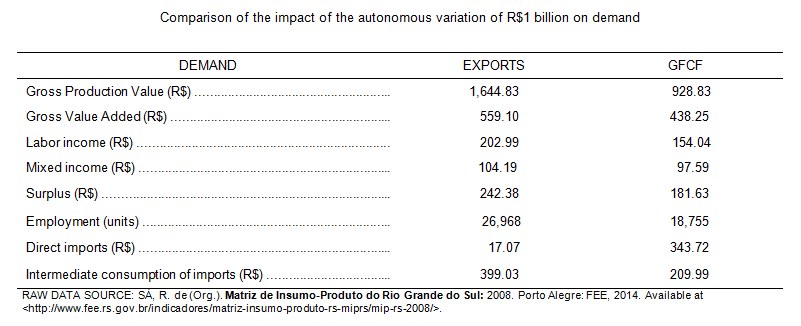Economists usually take the propensity to import as a universal parameter, regardless of the category of the final demand. However, this simplifying hypothesis does not hold empirically. In the case of Rio Grande do Sul’s economy, as well as the Brazilian one, the fixed capital investment propensity to import is greater than the export propensity to import. That happens in the exact extent to which investment tends to associate with innovation, and many times the inverting firm does not find, in the local market, an equipment supplier effectively equivalent to the model that is aimed at being incorporated into the plant. In this case, import is an imposition. On the other hand, it is extremely rare for imports to be simply re-exported, without any added value along the internal production process.
Since the exported goods are based on comparative and/or absolute advantages that present some stability in terms of the international division of labor, productive chains are structured around these goods, which unfold into large internal integration systems with low external leakage. In the terms of our discussion, it means that, given the productive structure of the state’s economy, little is imported when it comes to export, both in immediate (the exported good itself) and in mediate (the necessary inputs for the production of the good to be exported) terms.
These facts are evidenced even in a relatively superficial analysis of the 2008 Input-Output Matrix of Rio Grande do Sul (IOM-RS), which shows the sources of funds and the destinations of the state’s production.[1] According to the Economics and Statistics Foundation (FEE), the monetary value of exports (X) to other countries and that of the Gross Fixed Capital Formation (GFCF) were very similar in 2008: just over R$36 and R$34 billion respectively. Nevertheless, the imports directly associated with the GFCF totaled nearly R$12 billion (more than one third of the total), while the imports for exports did not exceed R$17 million.
Consider a final demand increase of about R$1 billion in the state’s economy even if such increase takes place either in the GFCF or in the foreign exports, and if it is distributed proportionally to the structures of these two categories of demand in 2008. As we can see in the table, the multipliers of the IOM-RS for the Gross Production Value (GPV), the Gross Value Added (GVA), the salary and the employment of these two demand categories are very different and always higher for exports than for the GFCF.
Leaks in the GFCF, i.e., the part of the initial demand thrust that ends up being directed towards imports are so high that we cannot strictly speak of a “multiplier” of the amount invested, for even if we take into account the indirect impacts of the investment demand, the GPV will grow below the initial demand variation. In contrast, the demand for exports is multiplied by 1.644, that is, after the initial demand thrust, the production of various segments of agribusiness, industry and services integrated to the production for export increases.
As the export chains demand more workers and are relatively more democratic in the distributive plan, being present in nearly all regions of the state, they foster an increase in income and employment significantly bigger, even though the so-called “income effect” has not even been computed yet. This effect is the one that comes from an increased demand for consumer goods derived from the expansion in income —wages, mixed income (such as those of family farmers, micro-entrepreneurs, etc.) and corporate earnings — appropriated by economic agents due to the expansion of the initial autonomous demand. As shown in the table, the impact of X is also bigger than the impact of the GFCF on these components, which brings us again to the same conclusion: in Rio Grande do Sul, exports are the autonomous demand component with the greatest potential for boosting income and employment. In the short and medium terms, it seems clear that the most effective strategy for mobilizing the state’s economy is supporting the growth and the modernization of its exports.
[1] SÁ, R. de (Org.). Matriz de Insumo-Produto do Rio Grande do Sul: 2008. Porto Alegre: FEE, 2014. Available at <http://www.fee.rs.gov.br/indicadores/matriz-insumo-produto-rs-miprs/mip-rs-2008/>.

